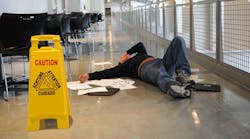Workplace Falls Pose a Danger to the Economy as well as Workers
After transportation-related deaths, falls are the No. 1 cause of death on the job, according to the Bureau of Labor Statistics (BLS). It should be no surprise that CFR 1926.501 Fall Protection is also the standard most cited by OSHA.
However, what is surprising to many is that OSHA has only been around since 1971. It also is a little shocking that accurate death and accident rates were not kept until 1992 by BLS. It is estimated that 14,000 workers were killed on the job in 1970. By comparison, in 2014, 4,821 workers died on the job while U.S. employment nearly doubled.
This is an example of the vast improvements that have been made as a result of OSHA regulations and enforcement and employers’ safety efforts over the past 45 years. If history repeats itself, OSHA and safety professionals will continue to make positive differences in workplace safety.
When it comes to falls at the workplace, OSHA’s focused efforts not only will prevent deaths, but also tragic disabilities. These disabilities often come with many large expenditures. Liberty Mutual estimates more than $61 billion per year is spent on disability claims in America with $15.57 billion, or 25.1 percent, resulting from falls (16.4 percent of falls to same level, 8.7 percent falls to a lower level). It is noteworthy that there is a category of slips and trips without a fall that cost another $2.35 billion, or 3.8 percent.
OSHA and safety professionals’ efforts to prevent falls also extends beyond the workplace to the home. In fact, 52 percent of unintentional injuries occur at home versus 13 percent at work, according to the National Safety Council’s 2012 Injury Facts. The NSC reports falls are the third leading cause of deaths from unintentional injuries. Poisoning and motor vehicle accidents lead the list.
Falls affect us as a society in a multitude of ways. For businesses in America, it is important to keep in mind that what happens off the job affects the workplace.
Workforce demographics indicate the labor force is shrinking as our population ages. As a result, the average age of workers is increasing dramatically. According the BLS, projected age changes in the workforce are:
- Workers ages 16-24 will decrease by 6.7 percent
- Workers ages 25-54 will increase by 2.4 percent
- Workers ages 55-64 will increase by 36.5 percent
- Workers ages 65-74 will increase by 83.4 percent
- Workers ages 75 and older will increase by 84.3 percent
Thus, addressing fall issues as they relate to disability and an increasing aging worker population is important for economic prosperity and the ethical stewardship of the safety profession.
Engineering Controls to Reduce Falls
Safety 101 typically starts with an attempt to engineer out known hazards before relying on human behavior modifications. Fall hazards are no exception.
Efforts should be made to work at identifying and eliminating trip hazards whenever possible. If the hazard cannot be eliminated, make the trip hazard conspicuous. Increase visual awareness of the hazard during dawn, dusk and night by adding high contrasting and reflective colors.
Pay attention to visual delineation for change of surface, transition areas, lighting (color, contrasts, shadows, intensity, etc.) and assure all are appropriate for use and the environment. Ramps, rails, slip-resistant floors and co-efficient of friction are all considerations to decrease fall risks.
In addition, housekeeping is not just about looking good, it is about being good! Items on the floor, such as liquids or improperly stored materials, are trip or slip hazards.
Gravity is a given, falling is not, thus the safety industry must start using all of its tools to begin to address this very important issue. It’s vital that safety professionals understand preventing falls aids the nation’s economic prosperity.
Workers help generate fiscal success for businesses, yet they must be safe. It is the job of safety professionals to protect workers, which ensures production doesn’t slow down and decreases disability costs. Losses from injuries can be avoided as safety professionals identify and reduce injury risks for the aging population, both at work and at home.
Melissa Black is an adjunct professor in occupational safety and health sciences at Columbia Southern University in the College of Safety and Emergency Services and Criminal Justice, Homeland Security. She obtained her master’s degree in Occupational Safety and Health from Columbia Southern University, holds both a Certified Safety Professional and a Certified Industrial Hygiene designation, and many additional certifications. She is the president of MsR3 LLC, a consulting firm. She works with clients in governments and businesses in various capacities to assist with risk reduction and safety performance.
